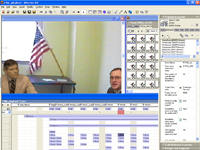 In this four year project, we developed The Designerʼs Augmented Reality Toolkit (DART) to allow for rapid prototyping of augmented reality (AR) applications by designers. DART was built on top of Macromedia (now Adobe) Director, a widely used multimedia development environment. We analyzed the most significant problems faced by designers working with AR in the real world, and designed DART to addresses them. Most of DART was implemented in an interpreted scripting language, and could be modified by designers to suit their needs. Our work focused on supporting early design activities, especially a rapid transition from storyboards to working experience, so that the experiential part of a design could be tested early and often. DART allowed designers to specify complex relationships between the physical and virtual worlds, and supported 3D animatic actors (informal, sketch-based content) in addition to more polished content. Designers can also capture and replay synchronized video and sensor data, allowing them to work off-site and to test specific parts of their experience more effectively. Throughout the years we developed many additional features for DART such as Wizard of Oz control (for user studies) and real-time sketch augmentations of the physical world (for early design activities) and we used the tool ourselves to build a variety of AR applications. The DART community consists of hundreds of users from both academia and industry and is still available for download (DART Download).
In this four year project, we developed The Designerʼs Augmented Reality Toolkit (DART) to allow for rapid prototyping of augmented reality (AR) applications by designers. DART was built on top of Macromedia (now Adobe) Director, a widely used multimedia development environment. We analyzed the most significant problems faced by designers working with AR in the real world, and designed DART to addresses them. Most of DART was implemented in an interpreted scripting language, and could be modified by designers to suit their needs. Our work focused on supporting early design activities, especially a rapid transition from storyboards to working experience, so that the experiential part of a design could be tested early and often. DART allowed designers to specify complex relationships between the physical and virtual worlds, and supported 3D animatic actors (informal, sketch-based content) in addition to more polished content. Designers can also capture and replay synchronized video and sensor data, allowing them to work off-site and to test specific parts of their experience more effectively. Throughout the years we developed many additional features for DART such as Wizard of Oz control (for user studies) and real-time sketch augmentations of the physical world (for early design activities) and we used the tool ourselves to build a variety of AR applications. The DART community consists of hundreds of users from both academia and industry and is still available for download (DART Download).
This work supported by NSF CAREER Grant 0347712.

1 ping
[…] Research Review Day, members of the AEL will be demonstrating a number of lab projects, including DART: the Designer’s Augmented Reality Toolkit, AIBAS: Adaptive Intent-Based Augmentation System, a scene-graph library for augmented reality […]